-
Posts
3556 -
Joined
-
Last visited
-
Days Won
2
Content Type
Forums
Events
Gallery
Posts posted by Rudy81
-
-
2 hours ago, Chris A said:
Look at the phase plots closely, looking for relative phase growth of different DSP filter configurations. Phase growth is just as bad as GD growth.
Unless I am doing something incorrectly, I don't see much in the way of phase changes. This plot is the original setup with a shelf and single EQ, vs. various timing changes....all with the two PEQ method and NO shelf. I don't see much in the way of phase change.
-
@Chris A, so far, all my testing shows virtually no difference in GD, spectrogram and SPL between using two PEQ points and using a shelf and one PEQ. I expected to see some big change in the phase profile, but not so. The phase continues to look as it does in the plots I posted above. Seems to me that using the shelf has little or no effect on the overall speaker response.
Timing differences, on the other hand, make a HUGE difference in the GD if you go too far away from ideal.
-
Here are the REW results for my current setup. I have a 1ms delay on the AMT stack. Some EQ on the open baffle H frames. I am ignoring the HF rolloff above 10kHz since that is due to mic placement. I can get relatively flat response in the HF, but the mic then is set very high off the floor relative to the bass OB.
The important thing to note relative to the current discussion is the 'crossover' region. I created that region using a combination low shelf and PEQ for the HF and a high shelf and PEQ for the LF. Overall, the results sound excellent, but I want to get closer to @Chris A and his technique of avoiding the use of the shelf and go with just PEQ.
-
@Chris A, thank you. Starting to make sense now. It just takes time to understand new information that seems to contradict everything you thought you understood to be correct. I will play around with the settings this afternoon.
-
@Chris A, thank you for the continuing explanations. In your other thread on the subject, you gave us this method of setting the PEQs.
"So all you have to do is put the HF and LF drivers together without phase shifts:
- Don't use the "crossover filters" that come with DSP crossovers--clear any crossover filters if they're set.
- Set the HF or LF channel delay to get perfect impulse response in the time domain--as seen in the spectrogram view.
- Flatten each driver's SPL response within their pass bands.
- Match the channel gains between flattened phase drivers.
- Use output channel PEQs to trim off response on each end of the bass and high frequency drivers until you've got overall flat SPL across the crossover interference band and smooth handover of SPL vs. frequency. The drivers themselves will tell you where that transition/crossover should occur. [If you're using MEHs, you'll have to use multiple PEQs to attenuate the bass bin peaks in response above the first notch frequency.]
- Use the input channel PEQs to further flatten the overall response within the interference band to correct any dips or peaks in response within that band.
Voila! Flat phase. It's really that easy."
It seems simple enough for the smart guys. In my case, my question concerns how many PEQ filters to use and what attenuation is appropriate. Looking at the settings on @Thaddeus Smith post, the attenuation seems rather modest for the Heils. -6dB @ 640hz. My question is, what does the Heil diaphragm see when it gets say a 50hz signal? I guess that's the part I'm having difficulty understanding. I always understood that part of the function of a xover was to protect those drivers that could not handle certain frequency ranges....such as a tweeter getting an LF signal.
Sorry to be so dense guys.
-
@Thaddeus Smith, you were correct on this whole crossover thing....and I was wrong! Apologies. Thank you for bringing up the issue so I can get my act together.
My Goldwood H frames have response up to 3kHz....so, do I simply use a series of PEQ filters to attenuate response?
-
40 minutes ago, rplace said:
@Rudy81 NOTE that Chris is saying and NOT shelf filters. I've switched to using only PEQs on mine. ie no shelf filters.
Thanks....PM inbound.
-
1 hour ago, Thaddeus Smith said:
In my dsp the crossover is set to "through," effectively sending full range signal to each channel. I've got peq filters in place, but nothing to cause a dramatic drop at any particular frequency to form a crossover. So we're both correct, but different? It sounds like I'm putting just a little more faith in Danleys theory that the driver's can't reproduce frequencies outside of their engineered band and therefore aren't at risk and you're creating peq shelves to ensure that.
I don't know enough about the Danley theory to trust a full range signal going to the tweeters. Makes one wonder why various named crossovers were developed to begin with.
-
 1
1
-
-
2 hours ago, ClaudeJ1 said:
It surprised me too, about 10 years ago, when I passed the Martin King information to my speaker builder friend (he subsequently gave me his single H frames and built taller OB's with 8 Alpha 15's per channel!!).
It was the most detailed bass I ever heard this side of bass Horns!!
Several times I read MJ King's papers on his Goldwood H frame design. I copied his frame dimensions and just added a second driver. So far, it seems to work exceedingly well. I'm amazed at how little the cones move when playing LF. More than enough bass for sure.
-
 1
1
-
-
1 minute ago, Chris A said:
If you're not using (named or first order) crossover filters, instead using PEQs only (and not shelf filters), then you've got effectively zero phase growth across the crossover region(s).
Chris
Very good. I guess I am implementing the concept correctly. I got confused when @Thaddeus Smith talked about sending a full signal to all drivers.
-
 1
1
-
-
7 minutes ago, Chris A said:
Not "incorrect", but you've got more phase growth (by about 90 degrees per order of crossover filters used) across the audible spectrum than if not using those "named" electrical crossover filters.
That's where I am confused. I am not using ANY named crossover. You can see that on the right side in the boxes LPF and HPF.....None is being used.
I created the attenuation you see by using a combination of a Low Shelf (PEQ1) and (PEQ2). The red line you see in the picture is another channel that does have a named filter. I overlay the channels and simulate the named xover by playing around with PEQ1 and PEQ2.
-
@Chris A, so am I implementing your (Danley) concept incorrectly by attenuating the frequencies as I have done? When I looked at the unwrapped phase of the full spectrum SPL, I did not see any major turns. Near the area where the drivers fade out and fade in, there is an increase in the slope, but it is gradual and there are no other changes once it is fully on the other driver.
If I have done it incorrectly, perhaps you may have time to review the no name xover implementation? Many thanks as always.
-
1 hour ago, Thaddeus Smith said:
will
Very interesting how you have your system set up. Hopefully @Chris A can take a minute and chime in on what is the PROPER way to set this up. I will post an older picture (with much higher xover point) of how I set up my EQ to create a no-name xover. This is an older screenshot, but I still use this technique. Same goes for the LF and I just manually adjust the position of the attenuation to give me a flat SPL within +/- 2dB.
-
49 minutes ago, carlthess40 said:
Could I use these to make one of the diy speakers ?
This is a replacement, without the wings and all. As I think I could make a oem type wing frame myself
What I’d like to know is this. Is there something else inside the frame work to make these work? Like a transformer or something

Sent from my iPhone using TapatalkYou are missing the magnet structure!
-
20 minutes ago, rplace said:
It's not that hard. You just have to learn the steps and apply them in the right order. Time consuming at first.
@rplace, I have to thank you! It was your private comment about the 'man who loves open baffle, but has none' that motivated me to take third look at a fully OB system!!!! This time, with proper drivers for OB. Drivers with a high Qts. My previous experiments with an I and H frame were all done with Eminence Kappalites, which have a very low Qts and do not perform as well in an OB situation.
Research into open baffles after that motivation led to re-discover that one of the BIG benefits of OB is that they tend to cause fewer room mode problems than conventional boxes due to the physics of dipoles. My REW runs the last few days proved that to be correct.
Not to distract from the main thrust of this thread, the Heil AMT stack. Just wanted to mention it since the OB LF completes the fully dipole speaker.
-
 2
2
-
-
15 minutes ago, RandyH said:
I really like this design , can we see what these cabs look like from the rear , and by curiosity , why does the open baffle design of the enclosure do so well with speakers that have a limited xmas ---
Here you go. I put two triangular braces behind the double thickness baffle. The top brace helps support the heavy twin stack. The bottom brace has the speakon connector installed.
-
 2
2
-
-
15 minutes ago, Thaddeus Smith said:
I'm still trying to grasp how he took my REW files and was able to come back with the peq filters, channel gains, and whether to apply the filters on the output vs input.
I worry about the inevitable future where I make system changes and he's not around to do it for me.
I use the EQ function in REW to create the PEQ points. I believe Chris does the same.
-
14 minutes ago, Thaddeus Smith said:
Totally fair, and maybe I'm still failing to grasp what Chris helped me setup. I just don't recall being able to see any sort of hard drop off in frequencies between my drivers once we were all done.
Perhaps Chris can chime in. Heck, I may be out to lunch.....Covid brain and all.
My understanding is that you use PEQ to attenuate the undesired frequencies. In my case, I use a shelf and a PEQ to attenuate the signal to -30dB. I can move the attenuation point just like you can set a named filter.
I can tell you this. I'm not sending a loud 100hz to the heils!
-
 1
1
-
-
31 minutes ago, Thaddeus Smith said:
3 months of usage have shown that vertical dispersion limits have no impact on enjoyment in real world listening situations.
I'm interested that @Rudy81 is reporting a hard set crossover frequency (via peq). When I went through the process with @Chris A we basically have all drivers running full range with peq adjustments to tame response towards flat, allowing the each driver's natural frequency response to handle the crossover. Or did miss something?
You are assuming facts not in evidence. I do not have a 'hard set' crossover frequency. I am using the 'no name' crossover technique that Chris mentions in various places. I mention 600hz, because the no name crossover is set to mimic a L/R 24dB crossover near 600hz. I don't see how you can run the Heils 'full range' without damaging the diaphragm when listening at reference levels.
Or.....perhaps I have misunderstood your comment.
-
3 hours ago, No.4 said:
I was seated right around the middle point of the two heils. Maybe a little lower. The difference now is night and day. My Bass bins are pushed into the corner though, so the back wave of the heils is firing pretty close to wall. I think yours are set up further from the wall so you may be getting more of the dipole effect, not sure. I even tried removing my wall treatments behind the heils, but it did not improve the sound. Quite the opposite.
I get the best HF sound while seated. If I stand up in the room, I definitely lose some high frequency performance.
Did some female vocal listening and thus far, no change from before the LF change. Vocals are clear and no issues with the crossover point. I do note a different type of bass performance with the OB H frames vs. the ported box. Sounds very clean and fast. I did note during the sweep runs that there is a lot LESS room interference showing up in the REW sweeps. I am assuming that is due to the dipole cancellation at the speaker plane. What a nice bonus!
Tonight will be continued testing and some music Blu Rays.
So far, the double AMT stack with an OB low end is sounding superb. No lack of bass at all with all these 18" drivers....frankly, that surprises me.
-
 2
2
-
-
Yes, my Heils are much further from the front wall. They are approximately 4 feet from the front wall and a similar amount from the side walls. The soundstage is just amazing. The dipole is in full effect at those distance and with the treatments I have. I have been working on timing and EQ this morning. Here are the results for the mains.
1 ms. delay
No name crossover at 600hz.
I had a heck of a time setting the mic up properly so as to avoid some mic placement anomalies that can be seen in the group delay. Best results were achieved with the mic lower relative to the stack than is necessary to see the true SPL results above 7khz. Not sure if the mic placement is being affected by the OB configuration, but it took a while to get it correct. The HF above 7khz is on the level with the rest of the results in actuality. The directionality of the Heil just doesn't show the actual performance due to where the mic was located. My focus on these REW runs were to get the correct timing and set the xover where I wanted it.
-
 2
2
-
-
2 minutes ago, No.4 said:
I have been crossing at 400hz since I have started this project. So far so good. I don’t listen at very high SPL usually though, and my room is small.
I have been experimenting with toe and the angle of the stacks. I raised the back feet of the stack/wings one inch so the stacks are angled towards the listing position. This made a huge difference in the vocal range and really focused the imaging. I reported a few pages back that the sound was more “live” while standing at the listening position. This angle has brought that “live” feel to the seated position. There is now no difference between the standing and seated position and the soundstage begins at a lower point in front of me. I am going to try a few more stack angles and toe adjustments to see if there are any further gains to be had, but I think I am close
I did run a few sweeps and adjusted a few PEQs before I did all of the new changes. The output of the heils has changed a little as they continue break in.
The sound quality I am getting From this setup at this point is nothing short of incredible. I have been considering building a pair of cornscalas for our living room to put my previous horns, compression drivers and ALK networks to good use. Now I don’t know....
What was the original height of the Heil stack relative to your ear position when seated? I created my bass bins, both ported and new H frames, to have the middle of the Heil stack exactly at seated ear height. Also, in my testing, I found that a ten degree toe in gives me the best sound. YMMV.
-
35 minutes ago, Thaddeus Smith said:

Hopefully the buyer helped manhandle them out of the house??
I let gravity do the work to get them downstairs. After that, craters and freighters handled the rest.
-
 1
1
-
-
2 minutes ago, carlthess40 said:
Wow. Great job. They look really good
How well do you hear the mids and female voices and vocalist ?
Sent from my iPhone using TapatalkAha! That's the all important question. I have yet to sit down to really listen critically to that level. Most of today was spent setting timing delay, xover and EQ. I did listen to a few songs and overall, after a quick listen, they sounded good. The bass was so nice, plenty of it and more transparent and quick than my ported cabs, which I liked quite a bit as well.
I set the xover just below 600hz, which is almost as low as the double stack can go. Hopefully tomorrow I will get a chance to see how well the double stack AMT integrates with the H frames. I sure do hope it works out. I sold the bass bins already, along with the Oris horns. Buyer wanted them, so that pushed me to this build. I have been without music for almost two weeks. Can't wait to get back to listening.
I'll report back. The SPL plots look very good at that xover point, so I am hopeful that the AMT can hold its own at that xover point. That was, in fact, the whole purpose of working on the double stack with wings.







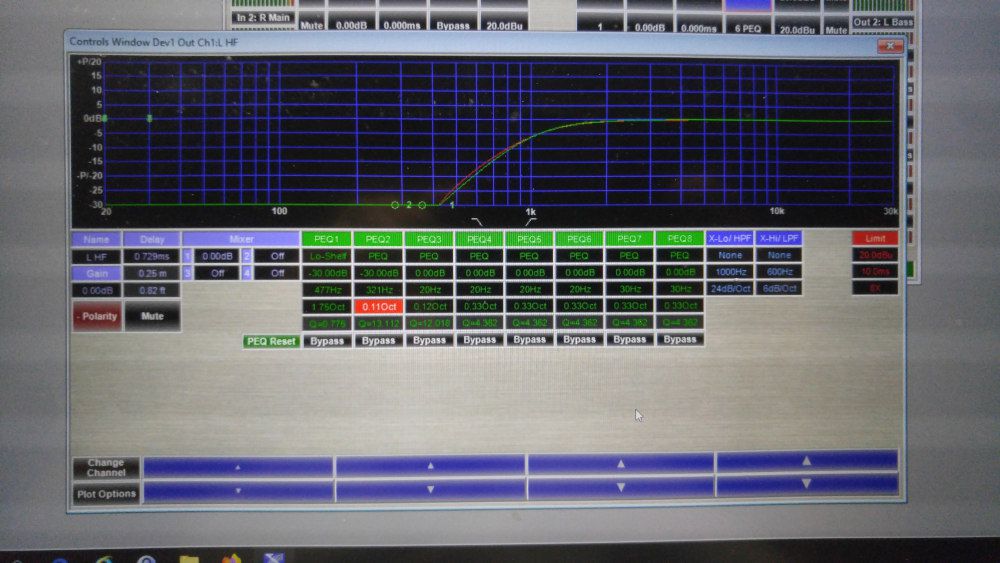

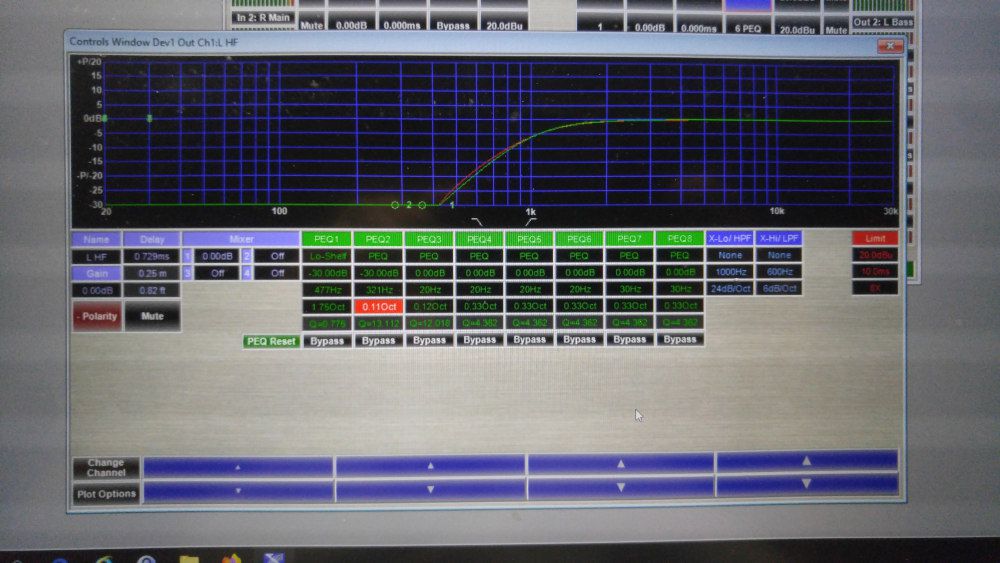



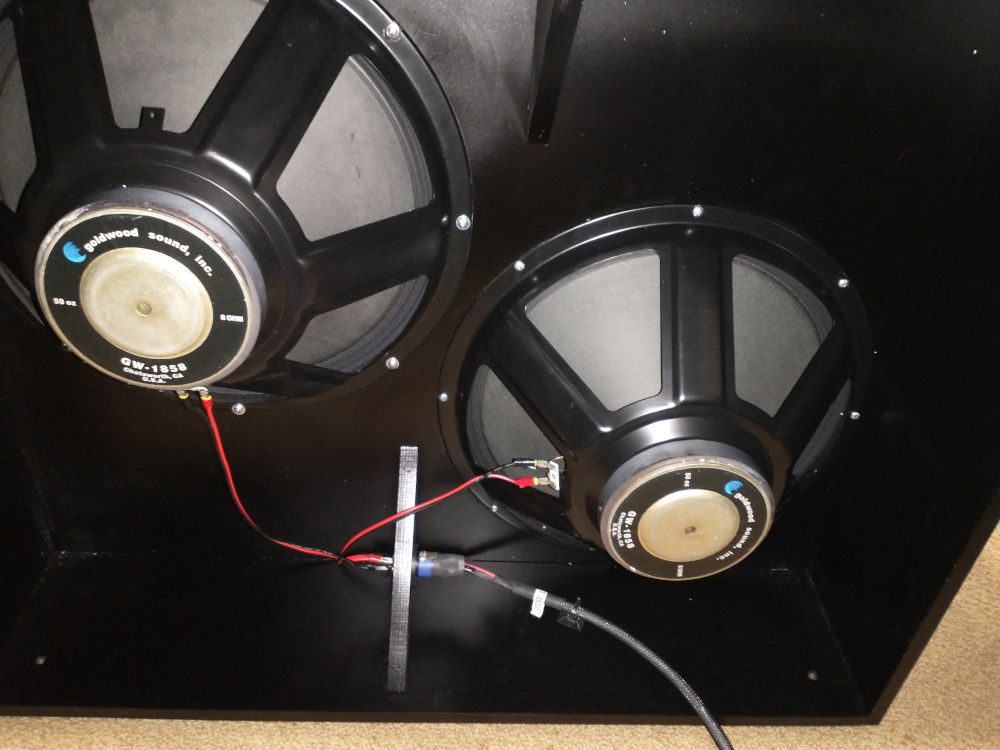
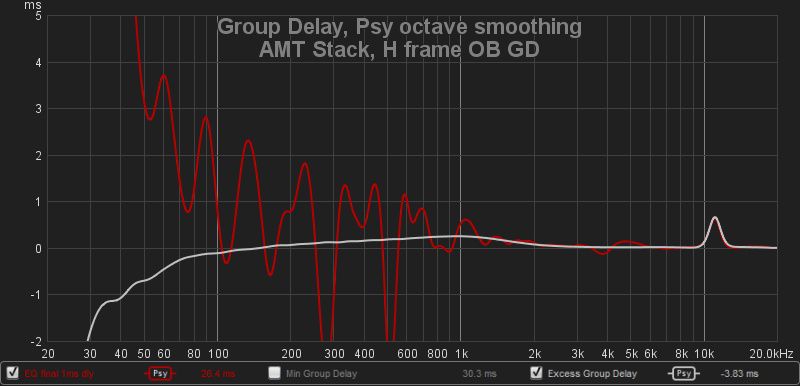

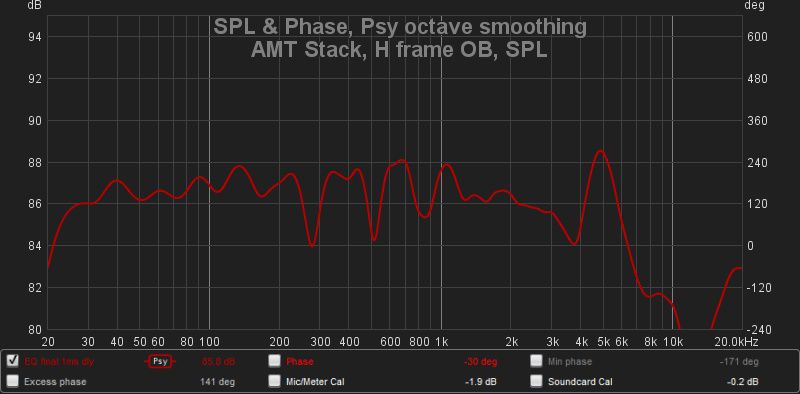

Double Stack ESS AMT-1 with Wings--Possible Kit for Heritage
in Technical/Restorations
Posted
I have now spent the better part of a day working strictly on optimizing the crossover region without using 'named' xovers, while monitoring effects on phase and GD. So far, I cannot detect much (if any) of a difference in using just PEQ vs. using a single PEQ and a shelf. In my trials I find that using the shelf and a single PEQ makes setting the xover region much easier. For the time being, I will leave it as is. I could not better the spectrogram or reduce phase growth using just the PEQ technique. I did manage to optimize the overall EQ settings to get the entire SPL within +/- 2 db, which in a room is pretty good IMHO.
Hopefully I am not missing some major point that would vastly improve performance.
I will note that when working with my system, an AMT stack and dual 18" woofers, mic placement takes a lot of trial and error. A couple of inches movement up or down at 3 feet can cause all sorts of anomalies in the GD plot. I am guessing there is some comb type filtering going on near the stack, causing the plot anomalies.